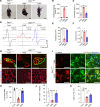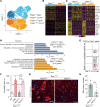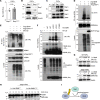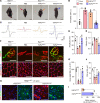Bap1/SMN axis in Dpp4+ skeletal muscle mesenchymal cells regulates the neuromuscular system
- PMID: 35603786
- PMCID: PMC9220848
- DOI: 10.1172/jci.insight.158380
Bap1/SMN axis in Dpp4+ skeletal muscle mesenchymal cells regulates the neuromuscular system
Abstract
The survival of motor neuron (SMN) protein is a major component of the pre-mRNA splicing machinery and is required for RNA metabolism. Although SMN has been considered a fundamental gene for the central nervous system, due to its relationship with neuromuscular diseases, such as spinal muscular atrophy, recent studies have also revealed the requirement of SMN in non-neuronal cells in the peripheral regions. Here, we report that the fibro-adipogenic progenitor subpopulation expressing Dpp4 (Dpp4+ FAPs) is required for the neuromuscular system. Furthermore, we also reveal that BRCA1-associated protein-1 (Bap1) is crucial for the stabilization of SMN in FAPs by preventing its ubiquitination-dependent degradation. Inactivation of Bap1 in FAPs decreased SMN levels and accompanied degeneration of the neuromuscular junction, leading to loss of motor neurons and muscle atrophy. Overexpression of the ubiquitination-resistant SMN variant, SMNK186R, in Bap1-null FAPs completely prevented neuromuscular degeneration. In addition, transplantation of Dpp4+ FAPs, but not Dpp4- FAPs, completely rescued neuromuscular defects. Our data reveal the crucial role of Bap1-mediated SMN stabilization in Dpp4+ FAPs for the neuromuscular system and provide the possibility of cell-based therapeutics to treat neuromuscular diseases.
Keywords: Cell Biology; Mouse models; Muscle; Muscle Biology; Neurodegeneration.
Figures








Similar articles
-
Depletion of SMN protein in mesenchymal progenitors impairs the development of bone and neuromuscular junction in spinal muscular atrophy.Elife. 2024 Feb 6;12:RP92731. doi: 10.7554/eLife.92731. Elife. 2024. PMID: 38318851 Free PMC article.
-
Mechanisms of exercise-induced survival motor neuron expression in the skeletal muscle of spinal muscular atrophy-like mice.J Physiol. 2019 Sep;597(18):4757-4778. doi: 10.1113/JP278454. Epub 2019 Aug 22. J Physiol. 2019. PMID: 31361024 Free PMC article.
-
A critical smn threshold in mice dictates onset of an intermediate spinal muscular atrophy phenotype associated with a distinct neuromuscular junction pathology.Neuromuscul Disord. 2012 Mar;22(3):263-76. doi: 10.1016/j.nmd.2011.09.007. Epub 2011 Nov 8. Neuromuscul Disord. 2012. PMID: 22071333
-
Spinal Muscular Atrophy: More than a Disease of Motor Neurons?Curr Mol Med. 2016;16(9):779-792. doi: 10.2174/1566524016666161128113338. Curr Mol Med. 2016. PMID: 27894243 Review.
-
Critical period of neuromuscular development: Importance for a new treatment of SMA.Neuromuscul Disord. 2018 May;28(5):385-393. doi: 10.1016/j.nmd.2018.03.007. Epub 2018 Mar 13. Neuromuscul Disord. 2018. PMID: 29610000 Review.
Cited by
-
Exploring the therapeutic potential of fibroadipogenic progenitors in muscle disease.J Neuromuscul Dis. 2025 Jan-Feb;12(1):22143602241298545. doi: 10.1177/22143602241298545. J Neuromuscul Dis. 2025. PMID: 39973455 Free PMC article. Review.
-
Depletion of SMN protein in mesenchymal progenitors impairs the development of bone and neuromuscular junction in spinal muscular atrophy.Elife. 2024 Feb 6;12:RP92731. doi: 10.7554/eLife.92731. Elife. 2024. PMID: 38318851 Free PMC article.
-
SMN controls neuromuscular junction integrity through U7 snRNP.Cell Rep. 2022 Sep 20;40(12):111393. doi: 10.1016/j.celrep.2022.111393. Cell Rep. 2022. PMID: 36130491 Free PMC article.
-
Improved therapeutic approach for spinal muscular atrophy via ubiquitination-resistant survival motor neuron variant.J Cachexia Sarcopenia Muscle. 2024 Aug;15(4):1404-1417. doi: 10.1002/jcsm.13486. Epub 2024 Apr 22. J Cachexia Sarcopenia Muscle. 2024. PMID: 38650097 Free PMC article.
-
Muscle-resident mesenchymal progenitors sense and repair peripheral nerve injury via the GDNF-BDNF axis.Elife. 2024 Sep 26;13:RP97662. doi: 10.7554/eLife.97662. Elife. 2024. PMID: 39324575 Free PMC article.
References
-
- Park GH, et al. Reduced survival of motor neuron (SMN) protein in motor neuronal progenitors functions cell autonomously to cause spinal muscular atrophy in model mice expressing the human centromeric (SMN2) gene. J Neurosci. 2010;30(36):12005–12019. doi: 10.1523/JNEUROSCI.2208-10.2010. - DOI - PMC - PubMed
Publication types
MeSH terms
LinkOut - more resources
Full Text Sources
Medical
Molecular Biology Databases
Research Materials
Miscellaneous

